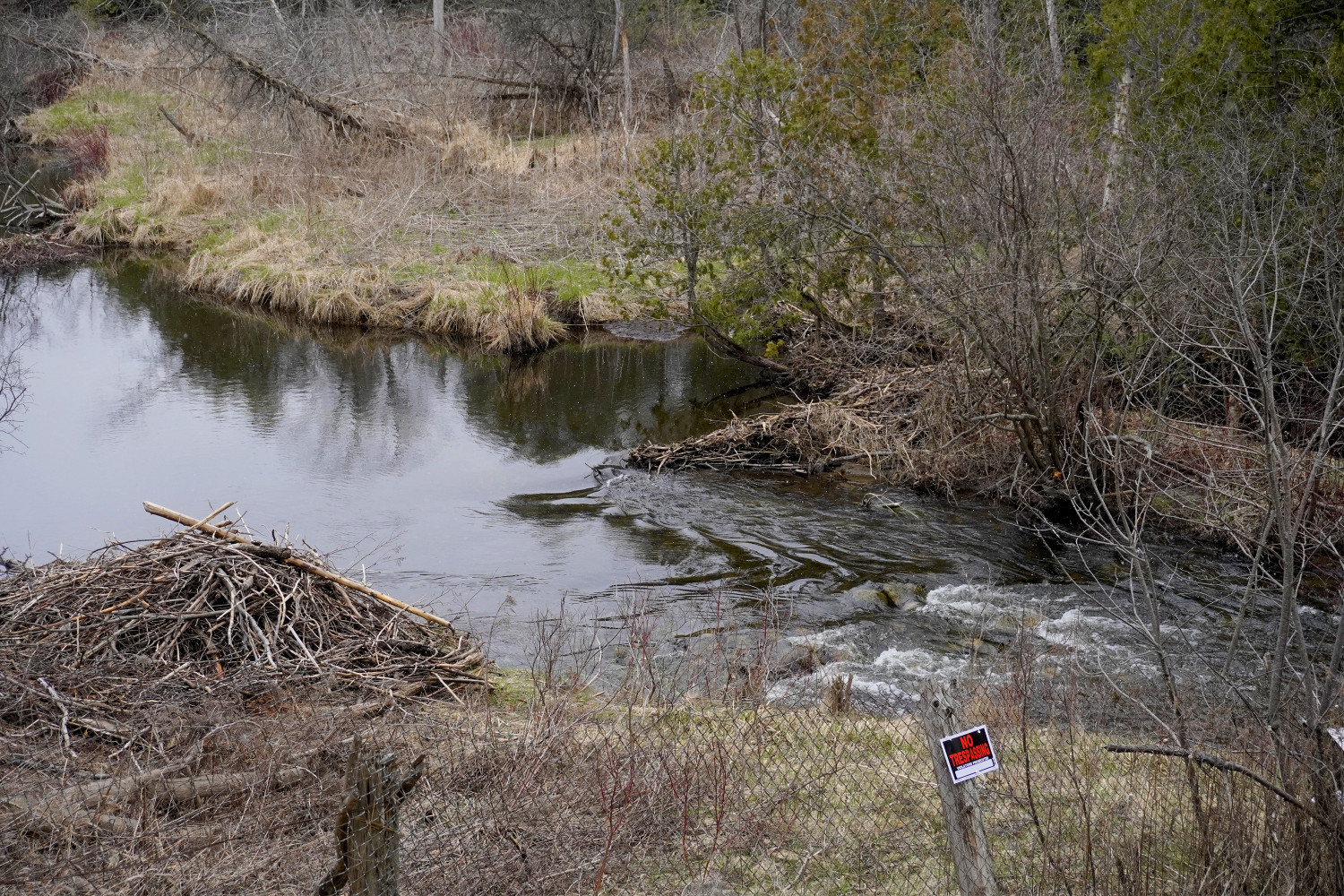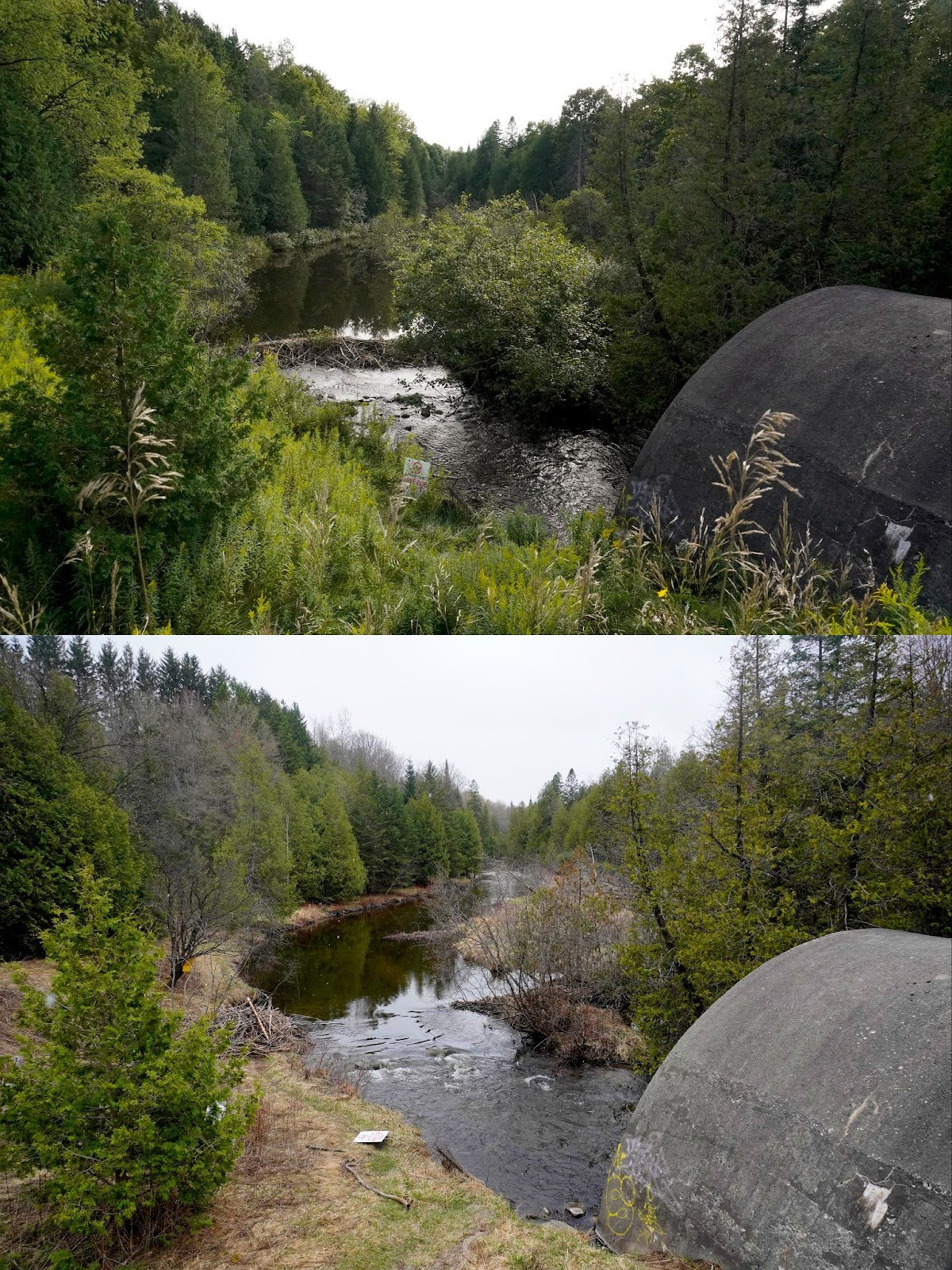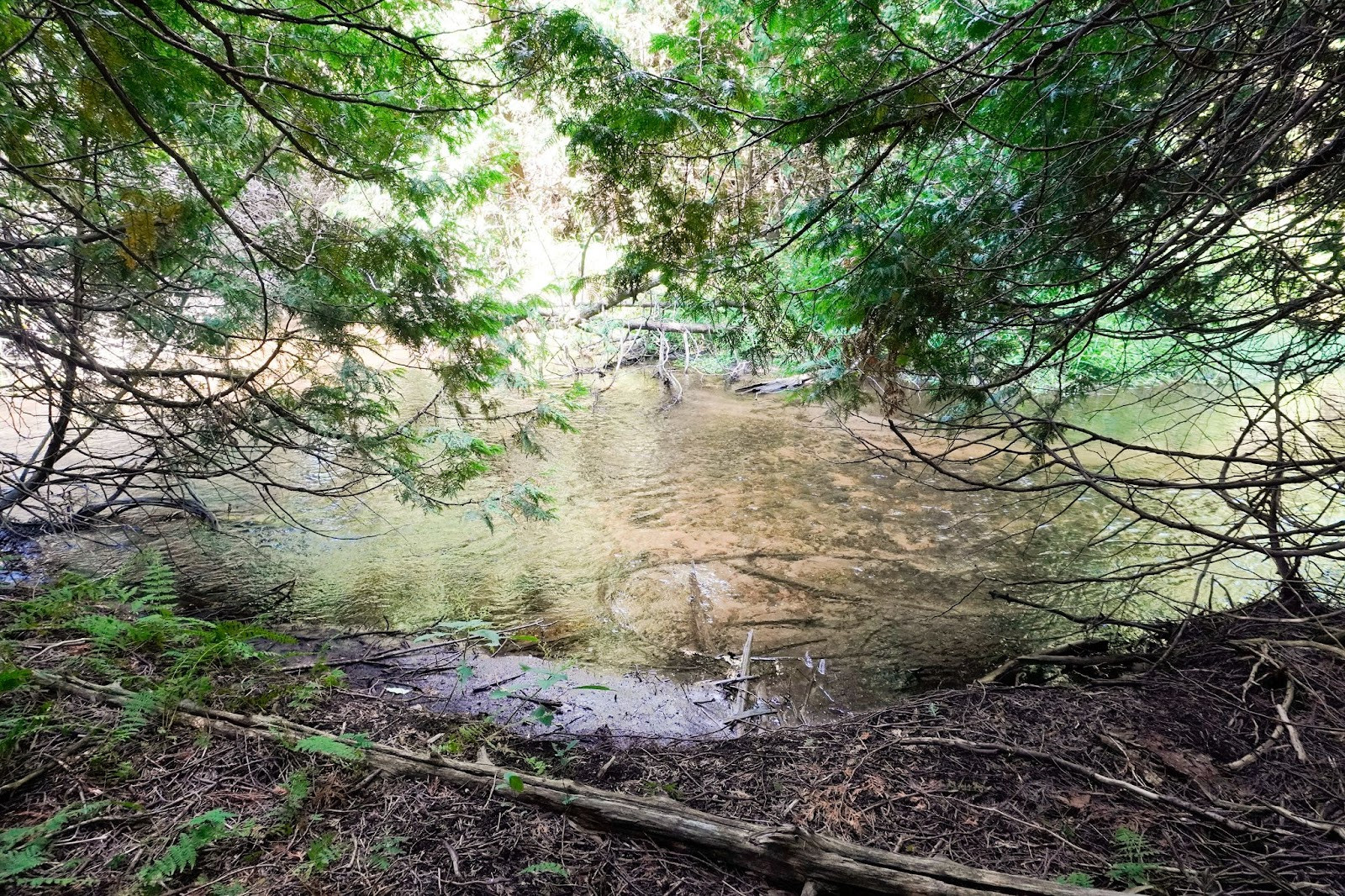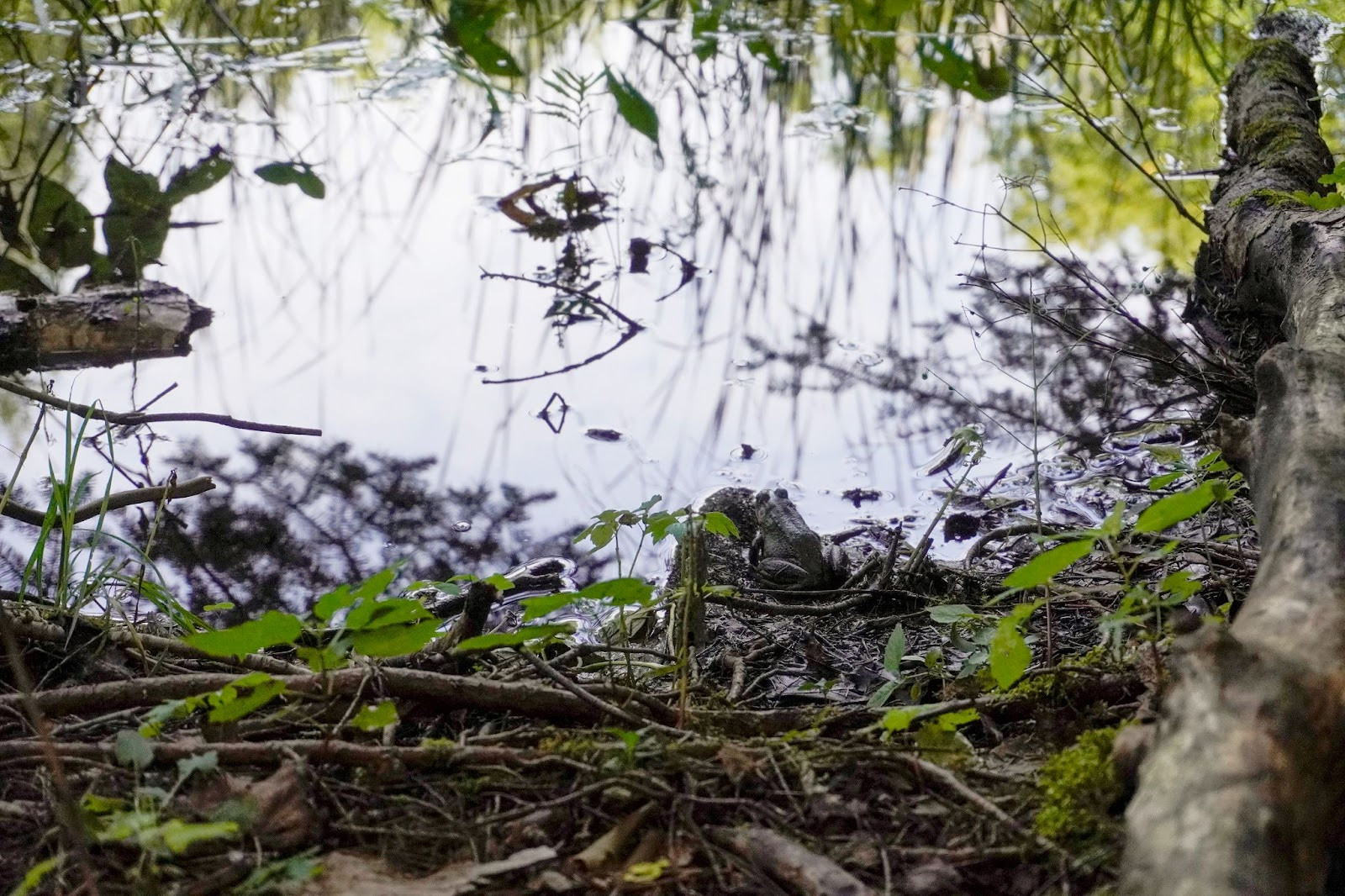
Erin residents claim Town’s destruction of beaver dam on West Credit River to allow effluent dumping broke the law
If glanced at quickly, it could be mistaken for a pile of debris. But what is really located at the base of a tributary of the West Credit River, just before the water flows under Winston Churchill Boulevard in Erin, is an intricate and intentionally crafted structure home to one of Canada’s symbolic animals: the beaver.
Over the past month, uproar has mounted across the town as the beaver dam has been destroyed, the latest in a line of controversies that have plagued the planning and construction process of the wastewater treatment facility in Erin, just north of Peel.
This dam in particular has housed generations of the beloved animal according to experts and nearby residents. Steve Noakes with the Coalition for the West Credit River says the family of beavers has been living in this area of the river for decades.
Beavers play a vital role in the wetland ecosystems they inhabit. Their work supports the development of ecological niches and encourages species diversity within the land, water and air.
The beaver is incredibly intelligent, so much so that humans have adopted their native technology to optimize the benefits of flowing water, constructing large, artificial dams of our own to control flooding, store water, and generate electricity.
Noakes says with a stable beaver population along the West Credit River, the removal of one dam or family won’t affect the overall health of aquatic life or the river, including the Brook trout species. The Brook trout has been a lightning rod for critics of the wastewater facility and its potential environmental consequences, who point out that plans to dump 7.2 million litres of effluent into the river every day once the Erin Wastewater Treatment Facilities are fully functional by 2028 could impact the sensitive fish species.
“There would be minimal impact from removing one family group from a specific area, depending on how large that area is,” Noakes told The Pointer. “Continual removal of beavers from an entire section of river may have some localized impacts as beavers are an integral part of ecosystem health and many species benefit from their presence. River channel morphology, sediment transfer and other geomorphic aspects of the river may also be altered from their permanent removal.”
The dismantling of the dam has raised questions about the legislation in place to protect these furbearing mammals, particularly laws enforced by the Department of Fisheries and Oceans Canada, and Ontario’s Ministry of Natural Resources and Forestry, and if its sudden removal broke such laws.

The beaver dam just west of Winston Churchill in September 2022 (top) and now.
(Alexis Wright/The Pointer)
The Department of Fisheries and Oceans Canada (DFO) administers the Fisheries Act which prohibits the removal or destruction of a beaver dam in cases where such action could alter or damage fish habitats. Removing a dam increases the speed the water flows, ultimately thinning the stream, affecting all of the other species, like turtles or salamanders, that inhabit it.
“Under the Fisheries Act, no one may carry out works, undertakings and activities that result in the harmful alteration, disruption or destruction of fish habitat, or the death of fish, unless it has been authorized by DFO,” states the Government of Canada website. “DFO's approval under the Species at Risk Act is also required if an activity affects an aquatic species at risk, any part of its critical habitat or the residences of its individuals.”
When the beaver dam was in place, the tributary of the West Credit was approximately six to seven metres wide, It is unknown to what degree the stream will be thinned and whether or not the new width would be suitable to support the amounts of effluent the Town plans to dump into the river once the treatment facility become active. With the volume of the stream decreased, it will be more susceptible to temperature spikes and chemical concentrations as a result of dumping effluent which will have profound impacts on the species in the river, of which the Brook Trout is a particular concern. While the Brook Trout is not officially listed as a species at risk in Ontario, its presence in the West Credit is paid particular attention because it is the last self-sustaining population of the species in southern Ontario.
The Pointer previously confirmed that neither the DFO or MNRF had been contacted by the Town of Erin or the Ministry of Environment, Conservation, and Parks (MECP) about the impacts on the Brook Trout or the removal of the beaver dam
The Ministry of Natural Resources and Forestry (MNRF) explained to The Pointer that dams can be removed by a landowner or agent of the landowner for the sole purpose of protection of property under the Fish and Wildlife Conservation Act or by a licensed trapper conducting regular trapping activities. An authorization is required to destroy a dam for any other reason.
In 2014, the MNRF issued a $1,500 fine to an Alberta company that removed a beaver dam near Savant Lake, in northwestern Ontario to drill in the area. The removal of the dam caused major flooding, which ultimately led to the fine.
“Municipalities are responsible for deciding on and taking appropriate actions when human-wildlife encounters create ongoing conflict situations on municipal property or infrastructure, and can also take action on private property with the permission of the landowner,” a spokesperson for the MNRF states. “The Fish and Wildlife Conservation Act allows municipalities to hire licensed hunters or trappers to help deal with problem furbearing mammals (such as coyotes, beavers, and skunks) within their municipal boundaries. No approval or authorization is required from the ministry in these cases.”
Tony Aleluia owns the property which holds the part of the stream where the dam was located. He has repeatedly stated he has no problem with the existence of the dam which was not causing any harm to his property.
Aleluia told The Pointer that he encountered someone on his property three times in recent months who appeared to be focussing on the dam. In the last visit, the dam was removed. After the trapper’s final visit to the property, Aleluia handed a cease and desist letter to Erin’s Mayor Michael Dehn.
“I had caught a trapper down there who was destroying the dam, and kicked him off the property. He indicated he was hired by the town,” Aleluia wrote to The Pointer in an email.
Aleluia declined to comment further over concerns of legal repercussions.
The Town of Erin periodically employs a MNRF-licensed trapper, a spokesperson explained to The Pointer, and that the Town was contacted by MNRF a few months ago regarding the beaver dam. The MNRF denies that such communication between the Town and the Ministry in regards to the dam took place
“MNRF has not been contacted by the landowner or the Town of Erin regarding the trapping of the beaver,” a spokesperson stated in an emailed response.
The Town asserts that the dam was located on Crown land, not private property, which could give them the authority to remove it if it was seen as conflicting with plans for the wastewater treatment plant. This is part of an ongoing dispute between Aleluia and the Town, with the Town alleging it has an easement for this part of Aleluia’s property. Aleluia says he was not made aware of any such easement when he purchased the property.
The Town claimed that the trapper was not contracted to destroy the dam, but admitted it may have been damaged in the process of trapping the beavers. Visually, there is no longer any sight of the dam on the stream.


Beavers unintentionally flood the landscape around their dam creating more biodiverse habitats for other animals such as reptiles or amphibians.
(Alexis Wright/The Pointer)
The beaver dam along the Credit in Erin has dramatically altered the flow of the river for at least half a century, according to residents of the Town. The small but stocky mammals have captured the attention of Noakes, who is also a videographer, who has described many active family groups of beavers along the river for decades.
“The beaver dam at Winston Churchill has been there for many years although they have rebuilt it in slightly different locations during that time,” Noakes previously told The Pointer.
No obvious fluvial consequences have occurred due to the removal of the dam, but Aleluia said the incident was reported to the Ministry of Natural Resources and Forestry, who, according to him, have yet to do anything about it.
The destruction of the dam comes after Aleluia was told by officials that in order to support the Town’s plans for dumping effluent, it would need to be removed.
In a previous visit to his property when Aleluia was first informed about the plans for the wastewater treatment plant, engineers and staff from the conservation authority went down to the river to assess the location for a future monitoring facility. Aleluia and others present at the time recalled an employee of the Credit Valley Conservation Authority stating that the beaver and its dam must be “evicted”.
The Pointer contacted CVC to confirm why a member of the conservation authority would make such a statement despite having no jurisdiction. The MRNF and DFO are the only regulatory agencies able to make such determinations. In a statement sent to The Pointer, CVC denied that a staff member made these comments.
“Personally, I feel this is yet another example of nature and wild spaces being pushed to the side in the name of progress. Cold water ecosystems are some of the most threatened and endangered habitats in Southern Ontario,” Noakes said.
“In most cases once they reach a certain point of degradation no amount of restoration can bring them back again. I find it extremely frustrating and disturbing that most are treated no better than a storm water ditch at the side of the road. Denying future generations the ability to go outside and experience them, learn from them and find peace in them should be something we should all be ashamed of.”
Email: r[email protected]
Twitter: @rachelnadia_
Email: [email protected]
Twitter: @lextoinfinity
At a time when vital public information is needed by everyone, The Pointer has taken down our paywall on all stories relating to the pandemic and those of public interest to ensure every resident of Brampton and Mississauga has access to the facts. For those who are able, we encourage you to consider a subscription. This will help us report on important public interest issues the community needs to know about now more than ever. You can register for a 30-day free trial HERE. Thereafter, The Pointer will charge $10 a month and you can cancel any time right on the website. Thank you
Submit a correction about this story


